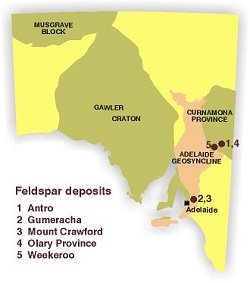
Feldspar
Feldspars are aluminosilicate minerals with varying amounts of potassium, sodium and calcium in a solid solution series. It is the most abundant mineral group, constituting ~60% of the Earth’s crust. The most common economic concentrations occur in pegmatites. Most commercial varieties are alkali feldspars, with composition between sodium and potassium end members, or at the sodic end of the plagioclase (sodium–calcium) group. The principal minerals are:
- Potassium feldspar
- ‘K-spar’: microcline or orthoclase, KAlSi3O8
- Sodium feldspar or ‘Na-spar’: albite, NaAlSi3O8
- Oligoclase, (Na,Ca)AlSi3O8
Feldspar is an important ingredient in glassmaking. In ceramics it acts as a flux which imparts the vitreous lustre to chinaware, sanitaryware and ceramic tiles. It is used in glazes and enamels, and is an important mineral filler in paints, plastics, sealants and adhesives.
World mine production is about 23 Mt/year with Turkey (30%) and Italy (20%) being the major producers. The Australian production about 94 000 t/year is dominated by Western Australia. In addition to this, ~50 000 t/year of a quartz–feldspar blend are produced for use in glassmaking by crushing granite near Beechworth, Victoria.
Pegmatites are found in all outcropping areas of Precambrian and early Palaeozoic rocks throughout the State, but the only significant production has been from deposits in the Mount Lofty Ranges and Olary Province. South Australia produced about 2100 tonnes of ablbite, an ornamental aggregate, from the Antro Deposit in the Olary Province in 2013.
Mount Lofty Ranges
South Australia’s major source of feldspar for many years was a pegmatite body within Adelaidean Burra Group sediments 2 km east of Gumeracha in the Mount Lofty Ranges. Approximately 56 000 t of mixed quartz–feldspar rock known as ‘chinastone’ were mined between 1933 and 1969 for the ceramics and glass industries.
From 1986 to 1989, 14 800 t of feldspar were mined from a partly kaolinised quartz–feldspar–muscovite pegmatite near the western margin of the Mount Crawford kaolinite–sillimanite orebody during a phase of quarry expansion.
Olary Province
Three types of feldspar deposits are hosted by Willyama Supergroup rocks in the Olary region (Fig. 1, (pdf ~ 140kb):
- Zoned pegmatite bodies up to ~300 m long, generally concordant with the enclosing metasediments. These pegmatites have quartz cores surrounded by coarse-grained microcline perthite, an alkali feldspar typically composed of 60–75% K-spar. They account for almost all of the 18 457 t of feldspar produced by selective mining of 21 individual pegmatites from 1932 to 1979.
- Poorly zoned albite-bearing pegmatite bodies, mostly discordant with the enclosing metasediments. The largest of these, near Antro woolshed 35 km northwest of Olary, has produced 139 661 tonnes of industrial feldspar and 2 107 tonnes of ornamental aggregate between 1987 and 2013.
- Irregular feldspar bodies at the northern albitised margin of a large Mesoproterozoic hornblende–albite amphibolite near Weekeroo Hill, 25 km north-northwest of Manna Hill. The largest is the Manna Hill Feldspar Deposit that produced 2 250 tonnes of albite between 1998 and its closure in 2001.
Additional reading
Olliver, J.G. and Steveson, B.G., 1984. Pegmatites in the Olary Province — feldspar and beryl mining. Mineral Resources Review, South Australia, 154:22-35.


